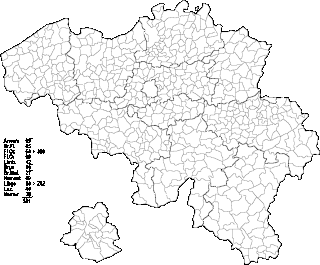
West Flanders is the westernmost province of the Flemish Region, in Belgium. It is the only coastal Belgian province, facing the North Sea to the northwest. It has land borders with the Dutch province of Zeeland to the northeast, the Flemish province of East Flanders to the east, the Walloon province of Hainaut in the south and the French department of Nord to the west. Its capital is Bruges (Brugge). Other important cities are Kortrijk in the south and Ostend (Oostende) on the coast, Roeselare and Ypres (Ieper). The province has an area of 3,197 km2 (1,234 sq mi) which is divided into eight administrative districts (arrondissementen) containing 64 municipalities. As of January 2024, West Flanders has a population of over 1.22 million.

Belgium comprises 581 municipalities, 300 of them grouped into five provinces in Flanders and 262 others in five provinces in Wallonia, while the remaining 19 are in the Brussels Capital Region, which is not divided in provinces. In most cases, the municipalities are the smallest administrative subdivisions of Belgium, but in municipalities with more than 100,000 inhabitants, on the initiative of the local council, sub-municipal administrative entities with elected councils may be created. As such, only Antwerp, having over 500,000 inhabitants, became subdivided into nine districts. The Belgian arrondissements, an administrative level between province and municipality, or the lowest judicial level, are in English sometimes called districts as well.

The Flemish Region, usually simply referred to as Flanders, is one of the three regions of Belgium—alongside the Walloon Region and the Brussels-Capital Region. Covering the northern portion of the country, the Flemish Region is primarily Dutch-speaking. With an area of 13,626 km2 (5,261 sq mi), it accounts for only 45% of Belgium's territory, but 58% of its population. It is one of the most densely populated regions of Europe with around 500/km2 (1,300/sq mi).

The Arrondissement of Ghent is the largest of the six administrative arrondissements in the Province of East Flanders, Belgium. It is both an administrative and a judicial arrondissement. However, the Judicial Arrondissement of Ghent also comprises the municipalities of the Arrondissement of Eeklo.

The Halle-Vilvoorde Arrondissement is one of the two administrative arrondissements in the Belgian province of Flemish Brabant. It almost completely surrounds the Brussels-Capital Region and lies to the west of the other arrondissement in the province, the Leuven Arrondissement. Unlike the Arrondissement of Leuven, it is not a judicial arrondissement; however since the sixth Belgian state reform in 2012–14, it has its own public prosecutor's service.

The Arrondissement of Aalst is one of the six administrative arrondissements in the Province of East Flanders, Belgium. It forms the Judicial Arrondissement of Dendermonde together with the Arrondissements of Dendermonde and Sint-Niklaas.

The Arrondissement of Antwerp is one of the three administrative arrondissements in Antwerp Province, Belgium. It is both an administrative and a judicial arrondissement. The territory of the Judicial Arrondissement of Antwerp coincides with that of the Administrative Arrondissement of Antwerp.

The Arrondissement of Dendermonde is one of the six administrative arrondissements in the Province of East Flanders, Belgium. It is both an administrative and a judicial arrondissement. However, the Judicial Arrondissement of Dendermonde also comprises the municipalities of the Arrondissements of Aalst and Sint-Niklaas.

The Arrondissement of Maaseik is one of the three administrative arrondissements in the Province of Limburg, Belgium. It is not a judicial arrondissement. The municipalities of Bocholt, Bree, Kinrooi, Meeuwen-Gruitrode, Dilsen-Stokkem and Maaseik, are part of the Judicial Arrondissement of Tongeren, while the rest of its municipalities are part of the Judicial Arrondissement of Hasselt.

The Arrondissement of Kortrijk is one of the eight administrative arrondissements in the Province of West Flanders, Belgium.
Science and technology in Flanders, being the Flemish Community and more specifically the northern region of Belgium (Europe), is well developed with the presence of several universities and research institutes. These are strongly spread over all Flemish cities, from Kortrijk and Bruges in the Western side, over Ghent as a major university center alongside Antwerp, Brussels and Leuven to Hasselt and Diepenbeek in the Eastern side.

The Arrondissement of Tielt is one of the eight administrative arrondissements in the Province of West Flanders, Belgium.

The Arrondissement of Tongeren is one of the three administrative arrondissements in the Province of Limburg, Belgium. It is both an administrative and a judicial arrondissement. However, the Judicial Arrondissement of Tongeren comprises the municipalities of Tongeren, Bocholt, Bree, Kinrooi, Meeuwen-Gruitrode, Dilsen-Stokkem and Maaseik in the Arrondissement of Maaseik and the municipalities of As, Genk, Opglabbeek and Zutendaal in the Arrondissement of Hasselt.

The Arrondissement of Mechelen is one of the three administrative arrondissements in the Province of Antwerp, Belgium. It is both an administrative and a judicial arrondissement, as the territory for both coincides.

The Arrondissement of Ypres is one of the eight administrative arrondissements in the Province of West Flanders, Belgium. It is both an administrative and a judicial arrondissement. However, the Judicial Arrondissement of Ypres also comprises the municipalities of Staden and Moorslede in the Arrondissement of Roeselare.

The Arrondissement of Roeselare is one of the eight administrative arrondissements in the Province of West Flanders, Belgium.

The Arrondissement of Veurne is one of the eight administrative arrondissements in the Province of West Flanders, Belgium. It is both an administrative and a judicial arrondissement. However, the Judicial Arrondissement of Veurne also comprises all municipalities in the Arrondissement of Diksmuide.
In Belgium, there are judicial and electoral cantons.

Legislative elections were held in Belgium in June and July 1884, for partial Chamber and full Senate elections respectively. Voter turnout was 79.1% in the Chamber of Representatives elections, although only 69,276 people were eligible to vote.

VIVES University of Applied Sciences is a University College in West Flanders. The name refers to the Spanish-Brussian humanist Juan Luis Vives. VIVES is the result of a merger between KATHO and KHBO in 2013.


















